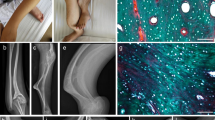Abstract
Background
Meyer dysplasia (MD) is a rare disease but readily mistaken for Legg-Calvé-Perthes disease (LCPD). Although most published studies on MD have characterized and differentiated it from LCPD radiologically and clinically, differences with regard to bone age delay and recovery have not been sought. We deemed it necessary to distinguish bone age delay and recovery patterns between the two entities for better differentiation, prognostication, and parental advice.
Methods
Bone age delay and recovery of eight patients who were initially diagnosed with LCPD but were found to have MD were retrospectively reviewed and compared with those of age-matched patients with LCPD. Based on hand radiographs, the radius-ulna-short bones (RUSs) and carpal bone ages were determined using the Tanner and Whitehouse 3 (TW3) method. Minimum follow-up was 2 years (range 2–5 years). Differences in RUS and carpal bone ages and recovery patterns between the two entities were analyzed using trend lines in scatter plots.
Results
The mean delay of RUS bone age was significantly less in MD (0.52 ± 0.87 years) than in LCPD (1.11 ± 0.99 years). However, the difference between the mean carpal bone age delay in MD (1.13 ± 1.28 years) and LCPD (1.47 ± 1.19 years) was not significant. Trend lines showed faster bone age recovery patterns in MD than in LCPD.
Conclusions
Bone age was delayed in both MD and LCPD but was less delayed in the former. RUS bone age showed more significant differences than carpal bone age when comparing the two entities and hence might be more useful for differentiating the two. Earlier bone age recovery patterns may be anticipated in patients with MD.
Similar content being viewed by others
References
Meyer J. Dysplasia epiphysealis capitis femoris: a clinical-radiological syndrome and its relationship to Legg-Calvé-Perthes disease. Acta Orthop Scand 1964;34:183–197.
Khermosh O, Wientroub S. Dysplasia epiphysealis capitis femoris: Meyer’s dysplasia. J Bone Joint Surg Br 1991;73:621–625.
Katz JF. Conservative treatment of Legg-Calve-Perthes disease. J Bone Joint Surg Am 1967;49:1043–1051.
Raimann A, de la Fuente M, Raimann A. [Femoral head dysplasia and its relationship to femoral head necrosis (Perthes’ disease).] Z Orthop Ihre Grenzgeb 1994;132:140–156.
Harel L, Kornreich L, Ashkenazi S, Rachmel A, Karmazyn B, Amir J. Meyer dysplasia in the differential diagnosis of hip disease in young children. Arch Pediatr Adolesc Med 1999;153:942–945.
Rowe SM, Chung JY, Moon ES, Yoon TR, Jung ST, Kim SS. Dysplasia epiphysealis capitis femoris: Meyer dysplasia. J Pediatr Orthop 2005;25:18–21.
Harrison CS. Dysplasia epiphysealis capitis femoris. Clin Orthop 1971;80:118–125.
Lee ST, Vaidya SV, Song HR, Lee SH, Suh SW, Telang SS. Bone age delay patterns in Legg-Calve-Perthes disease: an analysis using the Tanner and Whitehouse 3 method. J Pediatr Orthop 2007;27:198–203.
Burwell RG. Perthes’ disease: growth and aetiology. Arch Dis Child 1 1988;63:1408–1412.
Nelitz M, Lippacher S, Krauspe R, Reichel H. Perthes disease: current principles of diagnosis and treatment. Dtsch Arztebl Int 2009;106:517–523.
Rayner PH, Schwalbe SL, Hall DJ. An assessment of endocrine function in boys with Perthes’ disease. Clin Orthop 1 1986;(209):124–128.
Tanaka H, Tamura K, Takano K, Inoue N, Yoshioka H, Odera K, et al. Serum somatomedin A in Perthes’ disease. Acta Orthop Scand 1984;55:135–140.
Batory I. [The etiology of Perthes’ disease and its relation to femur head dysplasia.] Z Orthop Ihre Grenzgeb 1982;120:833–849.
Batory I. [Significance of the vascular development for ossification of the proximal femur epiphysis.] Z Orthop Ihre Grenzgeb 1982;120:690–693.
Maroteaux P, Hedon C. [Bilateral isolated dysplasia of the hip in the young child (author’s transl).] Ann Pediatr (Paris) 1981;28:653–659.
Bensahel H, Bok B. [Contribution of scintigraphy in noninfectious hip diseases in children.] Arch Fr Pediatr 1979; 36:1040–1045.
Author information
Authors and Affiliations
About this article
Cite this article
Sun, XT., Easwar, T.R., Cielo, B. et al. Comparison of bone age delay and recovery in Meyer dysplasia and Legg-Calvé-Perthes disease: a pilot study. J Orthop Sci 15, 746–752 (2010). https://doi.org/10.1007/s00776-010-1537-2
Received:
Accepted:
Published:
Issue Date:
DOI: https://doi.org/10.1007/s00776-010-1537-2




